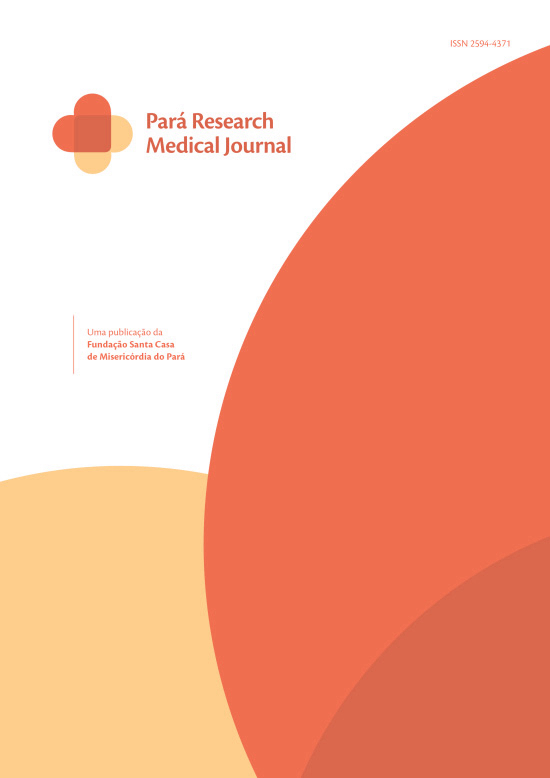Cranioencephalic trauma
a study of the proportions of conservative treatments in Brazil
DOI:
https://doi.org/10.4322/prmj.2020.008Keywords:
traumatism cranioencefalic, conservative treatment, brain injuryAbstract
Purpose: To analyze the degrees and proportions of cranioencephalic trauma treated conservatively in Brazil during the last decade. Methods: We collected data regarding conservative treatments of traumatic brain injury in Brazil, available in the Hospital Information System of the Brazilian Unified Health System (SIH/SUS), covering a time series from 2010 to 2019. Results: There were 835,253 conservative treatments related to mild, moderate and severe traumatic brain injury. This study found 68,061 deaths in patients with TBI, which is equivalent to 8.1% of the conservative procedures performed in each degree of cranioencephalic trauma. It was verified that the general deaths by cranioencephalic trauma treated conservatively, tend to increase according to the degree of severity (p - value 0, 0001). Conclusion: The research correlated to the proportions of conservative treatments of cranioencephalic trauma reveals - if important, especially in a country with continental dimensions and that, therefore, there is high heterogeneity of the cases and different TxM between the regions. It is essential that there is planning of prevention and health promotion to ponder and discuss about the TCE, as well as to elaborate effective policies
Downloads
References
Menon DK, Schwab K, Wright DW, Maas AI. Position statement: definition of traumatic brain injury. Arch Phys Med Rehabil. 2010;91(11):1637-40. http://dx.doi.org/10.1016/j.apmr.2010.05.017 . PMid:21044706.
Gardner RC, Dams-O’Connor K, Morrissey MR, Manley GT. Geriatric traumatic brain injury: epidemiology, outcomes, knowledge gaps, and future directions. J Neurotrauma. 2018;35(7):889-906. http://dx.doi.org/10.1089/neu.2017.5371. PMid:29212411 .
Wilberger JE, Mao G. Trauma cranioencefálico (TCE) [Internet]. Kenilworth, NJ: MSD; 2017 [citado em 2020 jun 23]. Disponível em: https://www.msdmanuals.com/pt-pt/profissional/les%C3%B5es-intoxica%C3%A7%C3%A3o/trauma-cranioencef%C3%A1lico-tce/trauma-cranioencef%C3%A1lico-tce
Olivertino PM. Conduta fisioterapêutica em crianças com traumatismo cranioencefálico submetidas a maus tratos [trabalho de conclusão de curso]. Uberaba: Universidade de Uberaba; 2018 [citado em 2020 jun 23]. Disponível em: http://dspace.uniube.br:8080/jspui/handle/123456789/553
Marincowitz C, Lecky FE, Townend W, Borakati A, Fabbri A, Sheldon TA. The risk of deterioration in GCS13-15 patients with traumatic brain injury identified by computed tomography imaging: a systematic review and meta-analysis. J Neurotrauma. 2018;35(5):703-18. http://dx.doi.org/10.1089/neu.2017.5259 . PMid:29324173.
Settervall CHC, Sousa RMC. Escala de coma de Glasgow e qualidade de vida pós-trauma cranioencefálico. Acta Paul Enferm. 2012;25(3):364-70. http://dx.doi.org/10.1590/S0103-21002012000300008 .
Passos MSC, Gomes KEP, Magalhães FG, Pinheiro S, De Paula CLP, Oliveira DML, et al. Clinical and sociodemographic profile of traumatic brain injury victims attended on emergency red area from a hospital reference in Trauma of Sergipe. Arq Bras Neurocir. 2015;34(4):274-9. http://dx.doi.org/10.1055/s-0035-1564886 .
Fernandes RNR, Silva M. Epidemiology of traumatic brain injury in Brazil. Arq Bras Neurocir. 2013;32(3):136-42. http://dx.doi.org/10.1055/s-0038-1626005 .
Brasil. Ministério da Saúde. SIHSUS - Sistema de Informações Hospitalares do SUS. Brasília: Ministério da Saúde; 2019.
Blennow K, Brody DL, Kochanek PM, Levin H, McKee A, Ribbers G, et al. Traumatic brain injuries. Nat Rev Dis Primers. 2016;2:16084. http://dx.doi.org/10.1038/nrdp.2016.84 . PMid:27853132.
Maia BG, Paula FRP, Cotta GD, Cota MAL, Públio PG, De Oliveira H, et al. Perfil clínico-epidemiológico das ocorrências de traumatismo cranioencefálico. Rev Neuroc. 2013;21(1):43-52. http://dx.doi.org/10.34024/rnc.2013.v21.8204 .
Plantier D, Luauté J. Drugs for behavior disorders after traumatic brain injury: systematic review and expert consensus leading to French recommendations for good practice. Ann Phys Rehabil Med. 2016;59(1):42-57. http://dx.doi.org/10.1016/j.rehab.2015.10.003 . PMid:26797170.
Carney N, Totten AM, O’Reilly C, Ullman JS, Hawryluk GWJ, Bell MJ, et al. uidelines for the management of severe traumatic brain injury, fourth edition. Neurosurgery. 2017;80(1):6-15. http://dx.doi.org/10.1227/NEU.0000000000001432 . PMid:27654000.
Oliveira EXG, Carvalho MS, Travassos C. Territórios do Sistema Único de Saúde: mapeamento das redes de atenção hospitalar. Cad Saude Publica. 2004;20(2):386-402. http://dx.doi.org/10.1590/S0102-311X2004000200006 . PMid:15073618.
Empresa Brasileira de Serviços Hospitalares – EBSERH. Reabilitação fisioterapêutica nos pacientes com diagnóstico de traumatismo cranioencefálico. Uberaba: EBSERH; 2018.
Brasil. Ministério da Saúde. Cadastro Nacional de Estabelecimentos de Saúde (CNES): notas técnicas. Brasília: Ministério da Saúde; 2019.
Brasil. Ministério da Saúde. Cadastro Nacional de Estabelecimentos de Saúde (CNES): consulta estabelecimento. Brasília: Ministério da Saúde; 2019.
Freitas AD, Franzon O. Lactate as predictor of mortality in polytrauma. ABCD. Arq Bras Cir Dig. 2015;28(3):163-6. http://dx.doi.org/10.1590/S0102-67202015000300004 . PMid:26537138.
Ruet A, Jourdan C, Bayen E, Darnoux E, Sahridj D, Ghout I, et al. Employment outcome four years after a severe traumatic brain injury: results of the Paris severe traumatic brain injury study. Disabil Rehabil. 2018;40(18):2200. http://dx.doi.org/10.1080/09638288.2017.1327992 . PMid:28521527.
Rutland-Brown W, Langlois JA, Thomas KE, Xi YL. Incidence of traumatic brain injury in the United States, 2003. J Head Trauma Rehabil. 2006;21(6):544-8. http://dx.doi.org/10.1097/00001199-200611000-00009 . PMid:17122685.
Adekoya N, Thurman DJ, White DD, Webb KW. Surveillance for traumatic brain injury deaths—United States 1989-1998. MMWR Surveill Summ. 2002;51(10):1-14. PMid:12529087.
Santos ME, Sousa L, Castro-Caldas A. Epidemiologia dos traumatismos crânio-encefálicos em Portugal. Acta Med Port. 2003;16(2):71-6. http://dx.doi.org/10.20344/amp.1153 . PMid:12828007.
Emami P, Czorlich P, Fritzsche FS, Westphal M, Rueger JM, Lefering R, et al. Impact of Glasgow Coma Scale score and pupil parameters on mortality and outcome in pediatric and adult severe traumatic brain injury: a retrospective, multicenter cohort study. J Neurosurg. 2017;126(3):760-7. http://dx.doi.org/10.3171/2016.1.JNS152385 . PMid:27035177.
Stein DM, Kozar RA, Livingston DH, Luchette F, Adams SD, Agrawal V, et al. Geriatric traumatic brain injury what we know and what we don’t. J Trauma Acute Care Surg. 2018;85(4):788-98. http://dx.doi.org/10.1097/TA.0000000000001910 . PMid:30256343.
Scholten AC, Haagsma JA, Andriessen TM, Vos PE, Steyerberg EW, van Beeck EF, et al. Health-related quality of life after mild, moderate and severe traumatic brain injury: patterns and predictors of suboptimal functioning during the first year after injury. Injury. 2015;46(4):616-24. http://dx.doi.org/10.1016/j.injury.2014.10.064 . PMid:25476014.
Lima ACB, Bonfim CV, Almeida AC, Gonçalves FR, Furtado BMASM. Qualidade de vida das vítimas de trauma cranioencefálico seis meses após o trauma. Rev Lat Am Enfermagem. 2019;4(20):97-106. http://dx.doi.org/10.12707/RIV18069


